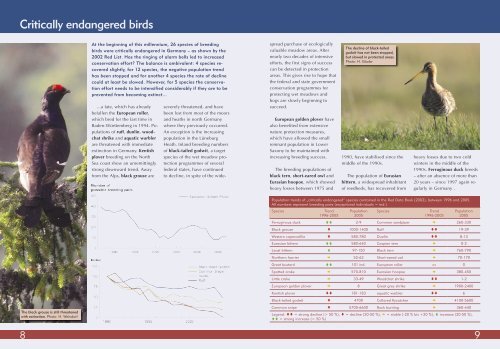Birds and Biodiversity in Germany - Bundesamt für Naturschutz
Birds and Biodiversity in Germany - Bundesamt für Naturschutz
Birds and Biodiversity in Germany - Bundesamt für Naturschutz
Create successful ePaper yourself
Turn your PDF publications into a flip-book with our unique Google optimized e-Paper software.
Critically endangered birds<br />
The black grouse is still threatened<br />
with ext<strong>in</strong>ction. Photo: H. We<strong>in</strong>dorf<br />
At the beg<strong>in</strong>n<strong>in</strong>g of this millennium, 26 species of breed<strong>in</strong>g<br />
birds were critically endangered <strong>in</strong> <strong>Germany</strong> – as shown by the<br />
2002 Red List. Has the r<strong>in</strong>g<strong>in</strong>g of alarm bells led to <strong>in</strong>creased<br />
conservation effort? The balance is ambivalent: 4 species recovered<br />
slightly, for 12 species, the negative population trend<br />
has been stopped <strong>and</strong> for another 4 species the rate of decl<strong>in</strong>e<br />
could at least be slowed. However, for 5 species the conservation<br />
effort needs to be <strong>in</strong>tensified considerably if they are to be<br />
prevented from becom<strong>in</strong>g ext<strong>in</strong>ct...<br />
...a fate, which has already<br />
befallen the European roller,<br />
which bred for the last time <strong>in</strong><br />
Baden-Württemberg <strong>in</strong> 1994. Populations<br />
of ruff, dunl<strong>in</strong>, woodchat<br />
shrike <strong>and</strong> aquatic warbler<br />
are threatened with immediate<br />
ext<strong>in</strong>ction <strong>in</strong> <strong>Germany</strong>. Kentish<br />
plover breed<strong>in</strong>g on the North<br />
Sea coast show an unremitt<strong>in</strong>gly<br />
strong downward trend. Away<br />
from the Alps, black grouse are<br />
severely threatened, <strong>and</strong> have<br />
been lost from most of the moors<br />
<strong>and</strong> heaths <strong>in</strong> north <strong>Germany</strong><br />
where they previously occurred.<br />
An exception is the <strong>in</strong>creas<strong>in</strong>g<br />
population <strong>in</strong> the Lüneburg<br />
Heath. Inl<strong>and</strong> breed<strong>in</strong>g numbers<br />
of black-tailed godwit, a target<br />
species of the wet meadow protection<br />
programmes of several<br />
federal states, have cont<strong>in</strong>ued<br />
to decl<strong>in</strong>e, <strong>in</strong> spite of the wide-<br />
spread purchase of ecologically<br />
valuable meadow areas. After<br />
nearly two decades of <strong>in</strong>tensive<br />
efforts, the first signs of success<br />
can be detected <strong>in</strong> protection<br />
areas. This gives rise to hope that<br />
the federal <strong>and</strong> state government<br />
conservation programmes for<br />
protect<strong>in</strong>g wet meadows <strong>and</strong><br />
bogs are slowly beg<strong>in</strong>n<strong>in</strong>g to<br />
succeed.<br />
European golden plover have<br />
also benefited from extensive<br />
nature protection measures,<br />
which have allowed the small<br />
remnant population <strong>in</strong> Lower<br />
Saxony to be ma<strong>in</strong>ta<strong>in</strong>ed with<br />
<strong>in</strong>creas<strong>in</strong>g breed<strong>in</strong>g success.<br />
The breed<strong>in</strong>g populations of<br />
black tern, short-eared owl <strong>and</strong><br />
Eurasian hoopoe, which showed<br />
heavy losses between 1975 <strong>and</strong><br />
Population trends of „critically endangered“ species conta<strong>in</strong>ed <strong>in</strong> the Red Data Book (2002), between 1996 <strong>and</strong> 2005.<br />
All numbers represent breed<strong>in</strong>g pairs (exceptional <strong>in</strong>dividuals = <strong>in</strong>d.)<br />
Species Trend<br />
1996-2005<br />
The decl<strong>in</strong>e of black-tailed<br />
godwit has not been stopped,<br />
but slowed <strong>in</strong> protected areas.<br />
Photo: H. Glader<br />
1990, have stabilised s<strong>in</strong>ce the<br />
middle of the 1990s.<br />
The population of Eurasian<br />
bittern, a widespread <strong>in</strong>habitant<br />
of reedbeds, has recovered from<br />
Population<br />
2005<br />
Species Trend<br />
1996-2005<br />
heavy losses due to two cold<br />
w<strong>in</strong>ters <strong>in</strong> the middle of the<br />
1990s. Ferrug<strong>in</strong>ous duck breeds<br />
– after an absence of more than<br />
20 years – s<strong>in</strong>ce 1997 aga<strong>in</strong> regularly<br />
<strong>in</strong> <strong>Germany</strong> .<br />
Population<br />
2005<br />
Ferrug<strong>in</strong>ous duck �� 2-9 Common s<strong>and</strong>piper � 260-330<br />
Black grouse � 1000-1400 Ruff �� 19-39<br />
Western capercaillie � 580-780 Dunl<strong>in</strong> �� 8-13<br />
Eurasian bittern �� 580-640 Caspian tern � 0-2<br />
Least bittern � 97-150 Black tern � 760-790<br />
Northern harrier � 52-62 Short-eared owl � 70-170<br />
Great bustard �� 101 <strong>in</strong>d. European roller ex 0<br />
Spotted crake � 570-810 Eurasian hoopoe � 380-450<br />
Little crake � 33-49 Woodchat shrike �� 1-2<br />
European golden plover � 8 Great grey shrike � 1900-2400<br />
Kentish plover �� 181-183 aquatic warbler �� 6<br />
Black-tailed godwit � 4700 Collared flycatcher � 4100-5600<br />
Common snipe � 5700-6600 Rock bunt<strong>in</strong>g � 360-440<br />
Legend: �� = strong decl<strong>in</strong>e (> 50 %), � = decl<strong>in</strong>e (20-50 %), � = stable (-20 % bis +20 %), � <strong>in</strong>crease (20-50 %),<br />
�� = strong <strong>in</strong>crease (> 50 %)<br />
8 9

















